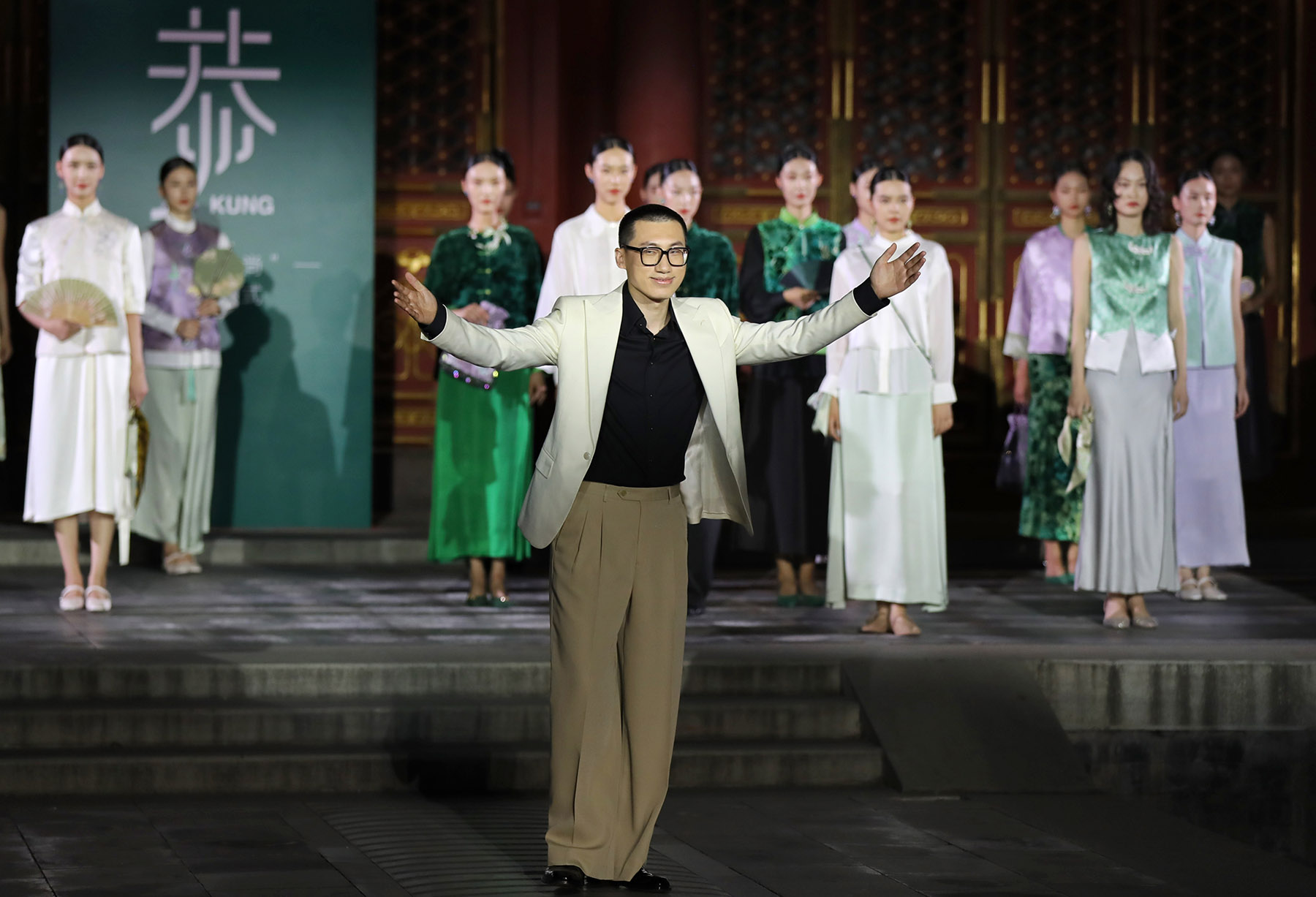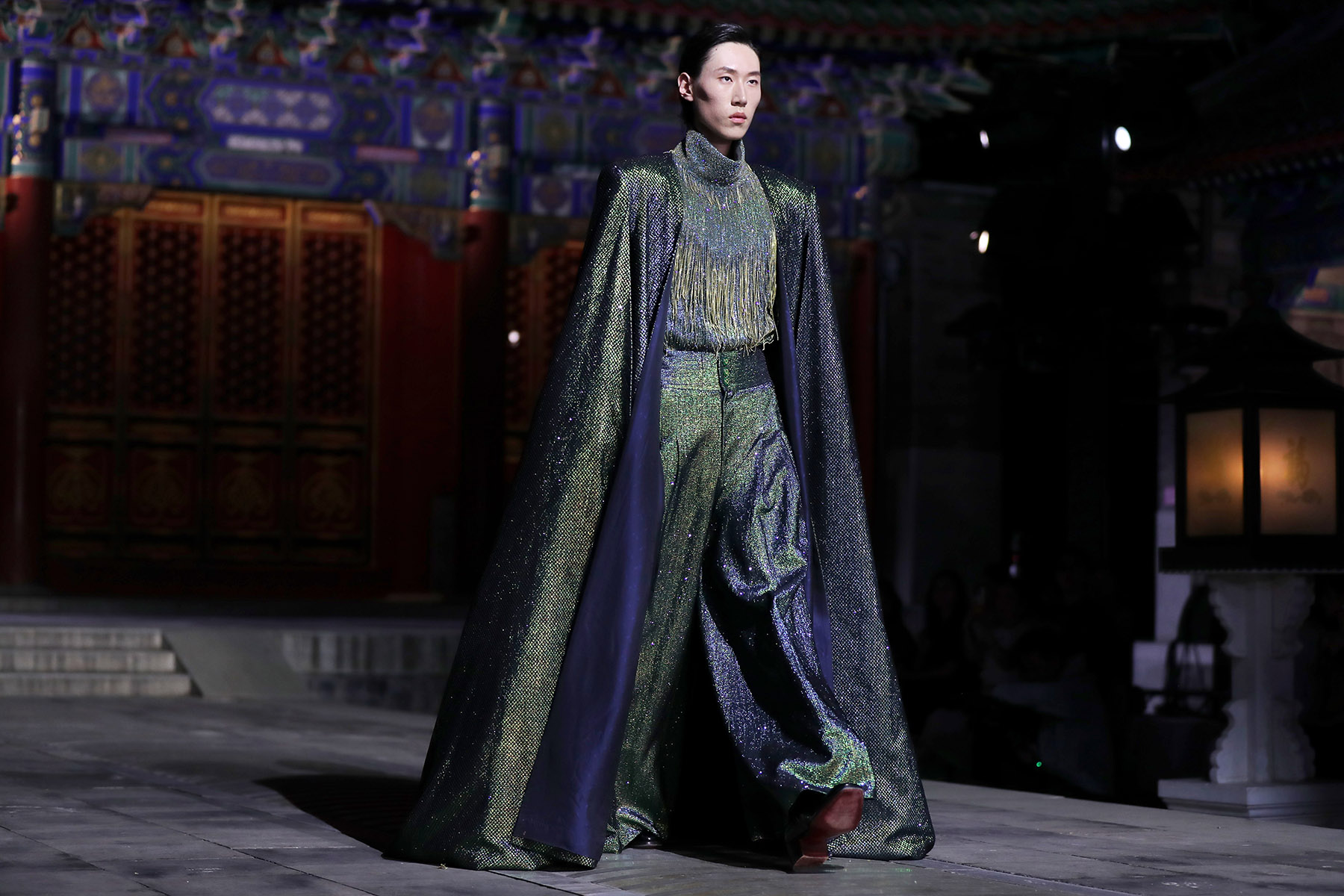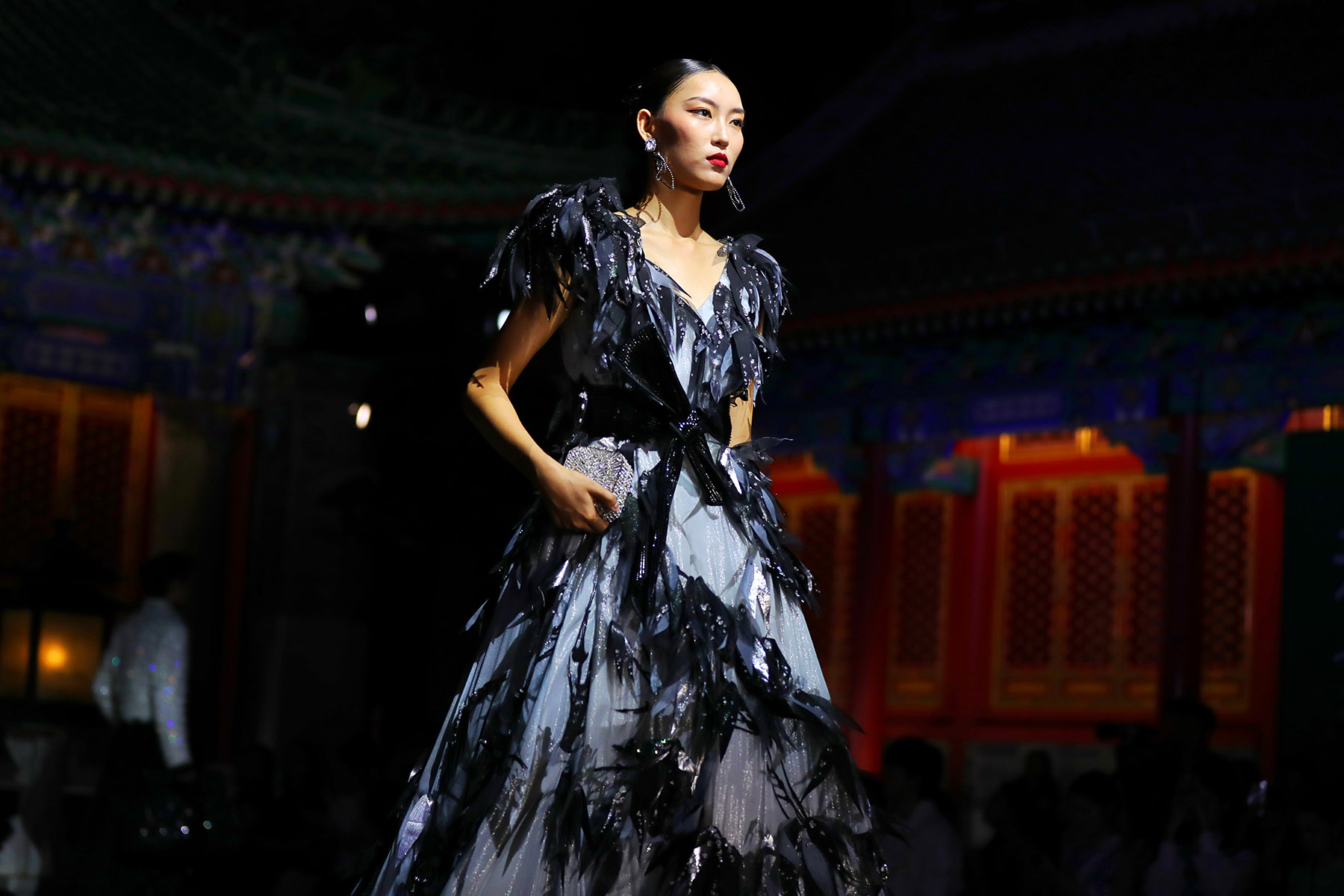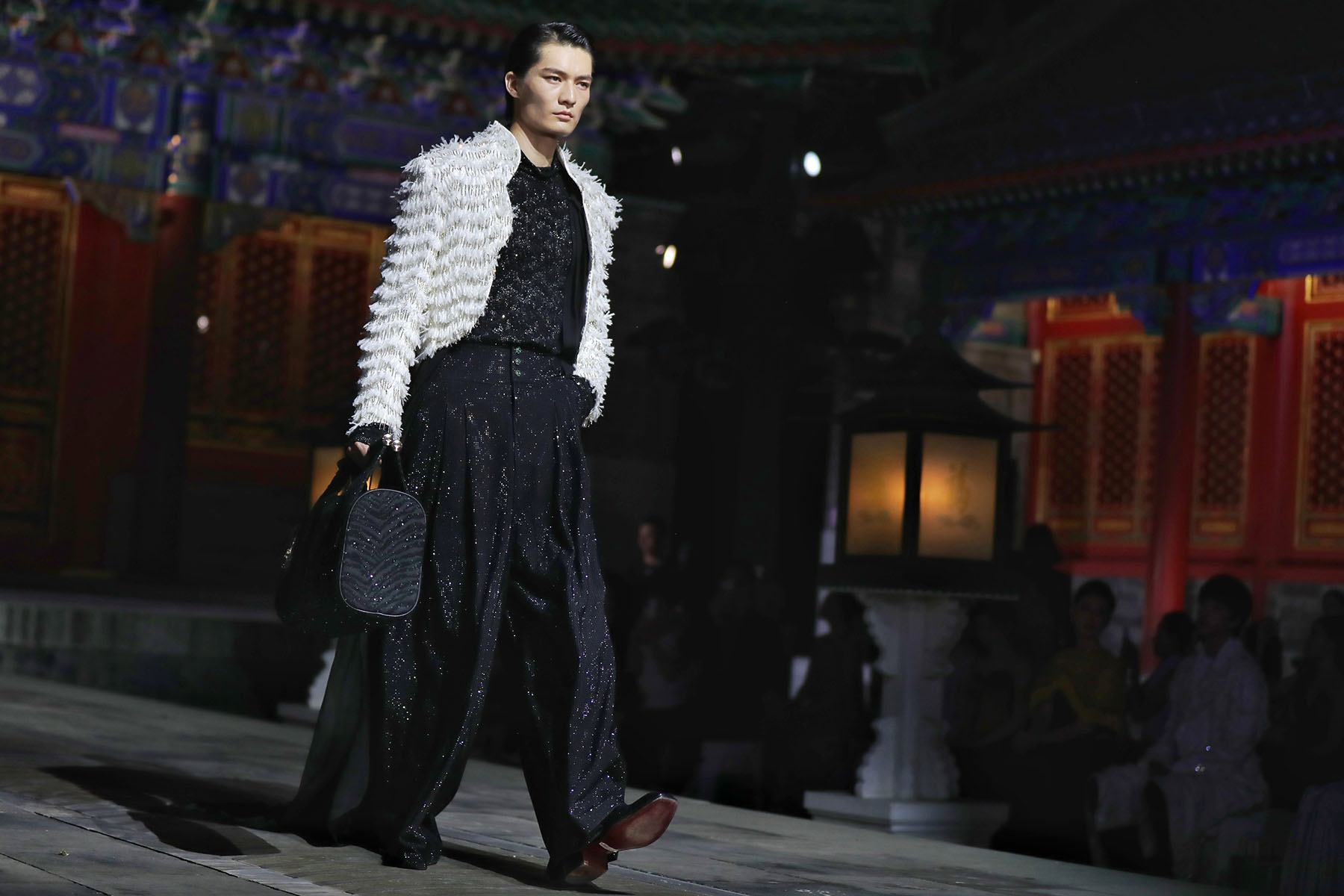Inspired by a prince's palatial residence, clothing designs reflect the stately architecture while blending contemporary styles, Yang Feiyue reports.

As stage lights danced across the solemn arches of Prince Kung's Palace Museum in Beijing, they cast a warm glow that brought the centuries-old structure to life. Against this historical backdrop, a spring collection inspired by the mansion's architectural details and natural landscapes set camera shutters clicking in rapid succession on a hot mid-July night.
Stepping gracefully onto the stage, actress Mao Xiaotong drew all eyes in a black gown that shimmered in the lights with a quiet elegance.
"The design was inspired by the flourishing lotus ponds of Prince Kung's Palace Museum in midsummer," she explains.
"The black base evokes the lotus flowers' tranquil beauty under the moonlight, and the hand-embroidered golden lotus leaves accented with dewdrops add a touch of delicate radiance."
Mao spoke of her fondness for the ensemble, praising how it captured the essence of Chinese aesthetics.
"It's like a subtle fragrance flowing in the air — a perfect blend of tradition and contemporary fashion."
READ MORE: Designing a future in fashion
Tucked away in downtown Beijing's hutong alleyways, the museum is one of China's best-preserved and iconic Qing Dynasty (1644-1911) princely residences. The complex blends traditional Chinese palatial architecture with refined gardens, featuring highlights such as the First Blessing Under Heaven Stele, a rare calligraphic work by Emperor Kangxi, and exquisite Western-style motifs in its rear garden.
As Mao strolled past the centuries-old architecture, her gown mirrored the palace's poetic landscape — the winding wisteria vines, the still ponds dotted with koi fish, and the fusion of East-West design through the garden's Baroque-inspired gates.
"I am impressed by how the designers translated the palace's beauty into fabric," Mao adds.

Her reflections echoed the essence of the event, which marked the launch of Kung Fashion, a new brand presented by the Prince Kung's Palace Museum.
Held in front of the palace's Yin'an Hall, the show attracted over 100 guests, including designers, cultural figures and fashion influencers, to witness the debut of its 2026 early spring collection.
The launch featured 37 conceptual outfits and 35 ready-to-wear pieces and accessories, all inspired by the museum's rich cultural heritage.
The collection weaves together classical Chinese elements, including lattice windows and bamboo groves, with intricate craftsmanship such as traditional gold embroidery and floral knotting, to speak a modern design language.
Following the debut showcase, collaborating designer Qi Qi emphasized that the ready-to-wear collection was designed to weave the cultural richness of the venue into practical, versatile pieces.
"The museum is known as a 'place of ten thousand blessings', so we wanted the garments to carry that sense of good fortune," Qi explains.
This vision has been materialized in subtle yet symbol-laden designs. The coin-shaped patterns are interlaced with bat motifs to symbolize prosperity and longevity. In Mandarin, the word for bat (fu) is a homophone for "blessing".
"We wanted to embed these cultural blessings into the garments so wearers could carry them as a quiet, everyday talisman," he adds.

Additionally, the ready-to-wear collection highlights the deep greens and muted purples replicated from the palace's bamboo groves and wisteria vines, as well as silhouettes that transition seamlessly between seasons.
"Key items like velvet jackets and sleeveless vests were created with layering in mind," Qi says.
"You can wear them in spring or autumn, and even summer over a light shirt. The apparel is about letting traditional blessings live in the details of modern life."
Among the guests trying on the collection was internet influencer Meng Yutong, who was surprised by how effortlessly the pieces fit into her everyday wardrobe.
"Today was my first time trying purple. It actually suits me," she says, admiring a lilac-toned outfit embroidered with the museum's signature wisteria motif.
"I used to think purple was challenging and not very versatile, but this set feels elegant and perfect for day-to-day wear."
She hails the experience as a revelation. "It's opened up a whole new style category for me. Whether it's a year-end company dinner or just a casual weekend outing, these modern Chinese pieces blend understated formality with personality," she says.
For Qi, the collection's "functional aesthetic" was as important as its cultural resonance. "Clothing isn't just an adornment," he reflects. "It's an everyday armor. We hope wearers will draw a quiet strength from these designs, whether they're stepping into a meeting or out for a stroll."
While Qi's designs reflect practicality and subtle cultural cues, Lawrence Xu's conceptual creations offer a bold, poetic counterpoint.
As the lights dimmed and flared again, Xu's 37 statement pieces unfolded like a scroll painting.

His series traced the palace's gardens through the four seasons. The first pieces bloomed with embroidered wisteria in soft lavenders, echoing the cascading vines of spring; midsummer's lotus ponds shimmered across flowing skirts in ink-black and gold, their surfaces dotted with crystal beads like dewdrops; autumn arrived in a riot of begonia motifs rendered in warm, earthy tones; and winter settled in with bamboo patterns etched onto silks that swayed like leaves in a cool breeze.
These statement pieces weave stories into fabric, Xu explains.
"They aren't inventions, but timeless storytelling pieces that have always existed. We're simply finding ways for them to resonate in the present," he says.
According to Zhao Juan, the general manager of the company for cultural development at the museum, the brand plans seasonal releases and designer collaborations to maintain its innovative edge while staying true to its cultural roots.
The museum's managing team emphasizes that the Kung Fashion initiative aims to infuse heritage into the rhythms of daily life through creative reinterpretation.
"We want to create a platform where cultural heritage comes alive — something people can see, touch, and experience," says Liu Shiyuan, director of the operations and management department with the museum.
Prince Kung's Palace Museum is not alone in this endeavor.
ALSO READ: Kids showcase creativity on the catwalk
Across China, more museums are exploring how cultural creativity and fashion can bring heritage into modern life.
At the National Museum of China, a horse-face skirt attracted widespread attention, with its design inspired by treasures like Empress Dowager Xiaoduan's phoenix crown from the Ming Dynasty (1368-1644), and the turquoise-glazed phoenix-and-peony vase made in Qing Dynasty.
From intricate embroidery to sleek silhouettes, museum-led fashion initiatives are boosting Chinese aesthetics to leap across time to find relevance in contemporary wardrobes.
Since its brand debut in Paris in 2023, the museum has actively promoted Chinese culture through fashion.
The Kung Fashion launch represents its latest efforts in pushing traditional art forms that evolve with contemporary lifestyles. "Through exhibitions, design spaces, and cultural products, we are exploring new ways for heritage to merge with modern life," Liu says.
Contact the writer at yangfeiyue@chinadaily.com.cn


